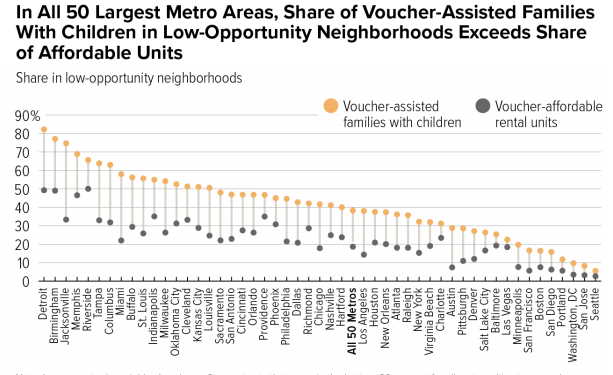What City Observatory did this week
1. Displacement by decline. Akron Planning Director Jason Segedy offers a guest post on our misplaced obsession with gentrification. He argues that pundits and urban policy people are fighting the wrong battle. Too much time is spent on the challenges of urban success, and not enough time is spent on poverty, disinvestment, segregation, and displacement by decline.
2. A paper tiger? Oregon’s constitutional limits on road tax use. Like many states Oregon has a “lock box” for its gas tax revenues: a constitutional provision that says that taxes on cars and auto fuel generally have to be used to build and maintain roads. Some have argued that this provision would prevent the Legislature from using funds from a carbon fee to pay for other things, like transit or environmental remediation (because carbon is indirectly a product of motor vehicle fuel). But the Oregon Constitution has two important exceptions to the limited uses of road funds: they can be used for credits and refunds, and also to repay debts. These two exemptions appear to give the Legislature plenty of leeway to provide a green dividend to Oregon households out of carbon fees, and to issue bonds to fund a variety of purposes, paid for from the same source.
Must read
1. Crime is trending down, but Americans think the opposite. The Pew Research Center has a helpful reminder of the yawning gap between the widely held belief that crime is trending upwards year after year, and the reality of a pronounced and continuing decline in recorded crime. Nearly every year for the past quarter century, two-thirds or more of American adults think crime went up in the past year. Over that same time, reported crimes have steadily declined, to the point that crime rates are about two-thirds lower than in the 1990s.
2. A condo sells for $1.25 million . . . in Detroit. The Detroit Free Press tells of a local family that just sold for $1.25 million the condo it bought a decade ago for less than a tenth that amount. It’s a clear sign that parts of Detroit (this is in the Brush Park neighborhood) are rebounding. While some take rising property values as an indication of gentrification, rising values help build wealth for those who own property in Detroit (and held on through some tough times). It’s also an indicator of optimism about the city’s future prospects. This rebound isn’t happening everywhere in the city, but as we’ve pointed out before, the nature of revitalization is it happens first in a few neighborhoods that achieve some critical mass. With luck, it will spread.
3. You can’t get lower CO2 without fewer VMT. California legal scholar Meredith Hankins draws a direct line between building places that allow and encourage less driving and achieving that state’s greenhouse gas reduction goals. Many are counting on technical fixes, like electric vehicles to counter global warming. She argues that “We’re never going to meet our GHG transportation goals unless we radically rethink our cities.” Hankins outlines the case for focusing on reducing vehicle miles of travel, and sketches out some of the goals the state should pursue, including quadrupling the number of trips taken on foot, shooting for a nine-fold increase in bike travel, and encouraging big increases in transit use. All those steps, and more will be needed to lower greenhouse gas emissions.
New Knowledge
Where housing choice vouchers help people live, by metropolitan area. One of the federal government’s principal housing programs for the poor is “Housing Choice Vouchers” also known as section 8. The program provides millions of families with a voucher that covers a substantial portion of their housing costs. Vouchers offer the potential for low income families to find housing in a wide range of neighborhoods, potentially escaping places of concentrated poverty. Whether vouchers produce this result depends on a variety of factors, including local zoning, landlord policies, and how local authorities administer the voucher program. A new report—Where Families With Children Use Housing Vouchers: A Comparative Look at the 50 Largest Metropolitan Areas—from the Council on Budget and Policy Priorities and the Poverty and Race Research Action Council provides a detailed picture at the allocation of vouchers.
In theory, vouchers ought to enable families to move to affordable locations with lower rates of poverty. But a consistent theme of the report is that voucher holders still tend to be more concentrated in high poverty neighborhoods, in spite of the fact that there are of potential affordable rental units in low poverty, high opportunity areas. In every large metro area, voucher using families are more concentrated in low opportunity neighborhoods than is affordable housing.
In addition to a comprehensive report, you will find a map showing the location of voucher-assisted housing in each metropolitan area, along with interactive data tables.
In the News
Next City pointed its readers to Daniel Kay Hertz’s commentary on the fundamental contradiction between our stated goals of using housing to create wealth and promoting housing affordability.
Willamette Week published City Observatory’s analysis of Census data on the proportion of single family homes in major cities in its article previewing proposed Oregon legislation that would legalizing “missing middle” housing throughout the state.




